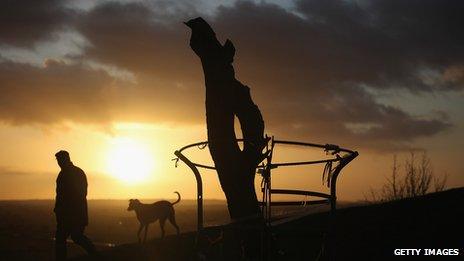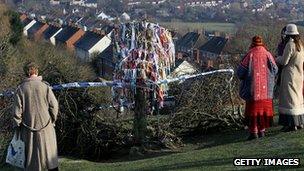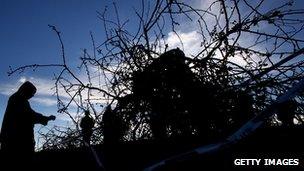The mystery over who attacked the Holy Thorn Tree
- Published

In the small hours of 8 December 2010, the Holy Thorn Tree of Glastonbury was cut down by somebody wielding a chain saw. Was it an act of mindless vandalism, or something more significant, asks Jolyon Jenkins.
According to legend, the thorn tree sprung from the staff of Joseph of Arimathea, Jesus's great-uncle, when he stuck it in the Somerset soil after voyaging to England in the 1st Century AD.
Whether or not the story is true, Glastonbury became an important early Christian centre, the site of an abbey founded in the 7th Century but closed down byHenry VIII.
Nowadays, though, it's not the Christians who are conspicuous in Glastonbury but the pagans who have flocked there.
"It's the heart chakra of the world," says Georgina Sirett-Armstrong-Smith, who is a priestess of Avalon at the local Goddess Temple. Others see strange forms and figures in the local landscape - a swan, a dragon, a pregnant woman.
Walking down the High Street, you could easily get the impression you have stumbled into Witchcraft Central. The shop names tell the story - The Cat and Cauldron, Man, Myth and Magick, The Goddess and Green Man, The Psychic Piglet.
Apart from witches and goddess worshippers, there are fairy followers, astrologers, shamans, alchemists, geomancers, druids, spiritualists and every possible variety of alternative healer.
So there are two mysteries of the holy thorn. One is who cut it down, and why? The other is why it seems to mean so much not just to Christians, but to pagans worldwide.
"We can see it from our front door," says Martin Wheeler, a local blogger.
"We will hear the women drumming up on the top of the hill. We will see the people dancing round the thorn. Drumming you usually get at a full moon."

Many gathered to see the tree after it was attacked - the cut branches were left at the base
When the tree was attacked, there was an online outpouring of grief. And when, a year later, new growth started to sprout from the trunk, the joy among international pagans was similar.
"Blessed Be the Holy Thorn - May it have as many fruit as the tears that have been shed," said one comment on the tree's Facebook page.
The thorn tree, however, is not all that it seems. The one that was cut down was definitely not planted by Joseph of Arimathea, but by a council official in the summer of 1951, to commemorate the Festival of Britain.
In fact, that one died due to drought, and was secretly replaced a few months later.
I found a small piece of it in a surprising place - the Covenstead Bed and Breakfast, whose owner is a witch, Adele Clough.
Clough displays her shrine to witchcraft on which she had placed a twig of the thorn. "Anything that is a symbol of peace and a symbol of love is something that all witches and Wiccans aspire to."
The former mayor John Coles tends to the remnants of the thorn. In recent years, people have tied ribbons to it bearing messages, prayers and maybe even spells.
Coles removes them. "It takes daylight away from the trunk," he explains. He also prises out the coins that people have jammed into the bark.
"This never used to happen even eight or nine years ago," he says sadly.
The apparent takeover of the town by new age believers disturbs him. "There's nothing wrong with paganism but there is a certain taste of Satanism as well and I have always regarded Glastonbury as a Christian town."
The local Catholic priest, Father Kevin Knox-Lecky, has also come across signs of Satanism.
"I have in the past found signs of rituals having been performed on the church steps. And that usually would involve candle grease and herbs and feathers, and sometimes blood," he says.
He doesn't think it's the work of local witches but outsiders. "I find it a nuisance when I have to clear it up, but that's as far as it goes really."
Knox-Lecky is relaxed about witchcraft and paganism, drawing the line only at the occasional attempts by local priestesses to co-opt the Virgin Mary into their pantheon of goddesses.
The Church of England vicar, David MacGeoch, seems a bit less sanguine. He moved to the town precisely because he "felt that Christianity in Glastonbury had got slightly lost".
"Many of us are here to put Christianity back on the map of Glastonbury," he says.

People took sprigs from the cut branches of the holy thorn
So who cut down the thorn? There are three theories, apart from the mundane explanation of mindless vandalism. First, that it was militant Christians opposed to its use as a pagan symbol.
Second, that it was militant pagans, opposed to its use as a Christian symbol. Third, that it was part of a private vendetta against a landowner.
But the case has gone cold. I only came across one lead, and not a very strong one.
MacGeoch was visited by a mystic who told him of a vision. That there were two men. That the chainsaw had been borrowed by somebody. And the person that he'd borrowed the chainsaw from didn't know the reason why. He told her to go to the police.
As for the extraordinary beliefs of Glastonbury's new residents, local historian Paul Ashdown takes the long view.
"The oldest version of the Glastonbury legend of all, which we find in the 900s, is the most outrageous of all in a sense.
"It says that no skill of man built the church in Glastonbury. It was prepared in heaven for the salvation of mankind.
"All later versions are, to varying degrees, rationalisations of this oldest belief that Glastonbury was one of the most special places in the world - a place where a church can just appear from the heavens."
After that, nothing about Glastonbury is surprising.
- Published3 April 2012
- Published9 December 2010